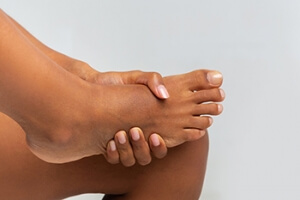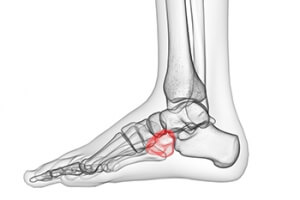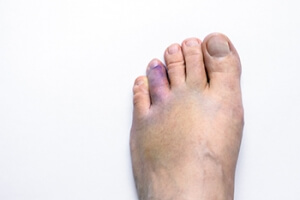Super User
Healing Under Pressure: The Science Behind Hyperbaric Oxygen Therapy (HBOT) for Foot Wounds
When it comes to the complex and often challenging world of foot wounds, finding effective treatments is crucial. For many patients dealing with diabetic foot ulcers, chronic wounds, or injuries that just won't seem to heal, Hyperbaric Oxygen Therapy (HBOT) offers a powerful solution. However, hope can be found with HBOT! Discover why it's becoming a game-changer in podiatry, especially at Favor Foot Ankle Leg & Wound Center.
Understanding Hyperbaric Oxygen Therapy (HBOT)
HBOT might sound like a cutting-edge concept, but its roots go back decades. The therapy involves breathing pure medical-grade oxygen in a pressurized chamber, allowing the lungs to gather more oxygen than normal atmospheric conditions provide. This increased oxygen is then dissolved into the plasma, the liquid part of the blood, at levels far beyond what can be achieved at normal air pressure. When this highly oxygenated blood reaches compromised or injured tissues, it kick-starts a cascade of healing mechanisms.
At a cellular level, oxygen plays a crucial role in energy production, metabolism, and cellular repair. With HBOT, cells receive an abundance of oxygen, promoting processes such as collagen synthesis, angiogenesis (formation of new blood vessels), and the production of fibroblasts, which are essential in wound healing. Additionally, the high-pressure environment of the hyperbaric chamber can also improve the ability of white blood cells to kill bacteria, further aiding in infection control.
This combination of increased oxygen delivery and enhanced cellular processes is what makes HBOT so effective in treating a variety of conditions, especially those involving poor circulation, compromised tissue viability, and chronic non-healing wounds.
How HBOT Helps Foot Wounds
Diabetic Foot Ulcers
Diabetes can lead to a range of complications, one of the most concerning being diabetic foot ulcers. These ulcers, often on the bottom of the feet, are slow to heal due to poor circulation and nerve damage. HBOT steps in by delivering high concentrations of oxygen to the wound site, stimulating new blood vessel formation (angiogenesis), reducing inflammation, and promoting the growth of healthy tissue. Approved for Wagner Grade 3 or higher diabetic ulcers, HBOT has proven to be an instrumental adjunct therapy helping to reduce amputations.
Chronic Wounds
Chronic wounds, whether stemming from injuries, surgery, or underlying health conditions, can be frustrating and debilitating. These wounds often struggle to progress through the normal stages of healing due to a variety of factors such as compromised circulation, infection, or impaired immune responses. Fortunately, HBOT offers a multi-faceted approach to healing these challenging wounds.
Non-Healing Injuries
Even seemingly minor injuries can become major issues if they refuse to heal. Non-healing injuries, whether due to poor circulation, compromised tissue viability, or underlying health conditions, can significantly impact one's quality of life. This is where Hyperbaric Oxygen Therapy (HBOT) steps in as a powerful ally in the healing process.
One of the primary benefits of HBOT for non-healing injuries is its ability to promote angiogenesis – the formation of new blood vessels. These blood vessels bring vital nutrients and oxygen to the injured site, creating an optimal environment for tissue repair. Additionally, HBOT enhances cellular metabolism and collagen production, essential components of tissue regeneration.
In cases of bone injuries, such as stress fractures or delayed union fractures, HBOT plays a crucial role in bone healing. The oxygen-rich environment promotes osteoblast activity, the cells responsible for bone formation, leading to accelerated healing and strengthening of the bone.
Soft tissue injuries, such as ligament sprains or muscle tears, also benefit from HBOT. The therapy reduces inflammation, alleviates pain, and supports the repair and regeneration of damaged tissue. Athletes, in particular, find HBOT invaluable for getting back to their sport faster and stronger.
Who Can Benefit from HBOT?
At Favor Foot Ankle Leg & Wound Center, we've seen firsthand the transformative effects of HBOT on a range of patients:
Diabetic Individuals: Those with diabetic foot ulcers or neuropathy find relief and accelerated healing with HBOT.
Athletes: Sports-related foot injuries such as stress fractures, ligament tears, and tendonitis can benefit from HBOT's ability to speed up recovery times.
Chronic Wound Patients: Individuals dealing with wounds that refuse to heal despite traditional treatments often find success with HBOT.
Post-Surgery Patients: HBOT is an excellent complement to post-surgery care, helping surgical wounds heal faster and reducing the risk of complications.
Hyperbaric Oxygen Therapy (HBOT) offers a beacon of hope for those struggling with foot wounds that just won't heal. Its ability to deliver concentrated oxygen to the body's tissues has shown remarkable results in diabetic foot ulcers, chronic wounds, and non-healing injuries. At Favor Foot Ankle Leg & Wound Center, we're proud to offer this advanced therapy to our patients, witnessing firsthand the restoration of mobility, comfort, and quality of life it brings.
If you or a loved one are dealing with foot wounds, chronic ulcers, or injuries, don't hesitate to reach out to us. Together, we can explore how HBOT might be the key to your healing journey.
If you have any questions, please feel free to contact our offices located in South Amboyand Edison, NJ. We offer the newest diagnostic and treatment technologies for all your foot care needs.
Beyond Bandage: Demystifying Advanced Wound Care in Podiatry
W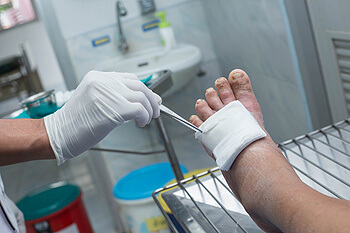 hen it comes to foot and ankle health, wounds can present a significant challenge. Whether it's a diabetic foot ulcer, a chronic injury, or a post-surgery complication, effective wound care is essential for proper healing and preventing further complications. Fortunately, in the world of podiatry, there's a powerful tool that's changing the game: Advanced Wound Care. At Favor Foot Ankle Leg & Wound Center, we're committed to staying at the forefront of these innovative techniques to provide our patients with the best possible care.
hen it comes to foot and ankle health, wounds can present a significant challenge. Whether it's a diabetic foot ulcer, a chronic injury, or a post-surgery complication, effective wound care is essential for proper healing and preventing further complications. Fortunately, in the world of podiatry, there's a powerful tool that's changing the game: Advanced Wound Care. At Favor Foot Ankle Leg & Wound Center, we're committed to staying at the forefront of these innovative techniques to provide our patients with the best possible care.
What is Advanced Wound Care?
Advanced Wound Care goes beyond the traditional bandages and dressings. It encompasses a range of sophisticated techniques and technologies designed to promote optimal wound healing. These techniques are grounded in the latest scientific research and offer new hope for patients with wounds that have been slow to heal or have not responded to conventional treatments.
The Significance of Advanced Wound Care
Accelerated Healing
One of the primary benefits of advanced wound care is its ability to accelerate the healing process. Techniques such as negative pressure wound therapy (NPWT), which uses vacuum-assisted closure, help remove excess fluid, reduce swelling, and promote the growth of healthy tissue. This means wounds that once lingered for weeks or months can now show significant improvement in a fraction of the time.
Reduced Risk of Infection
Infections are a major concern with any wound, especially for individuals with diabetes or compromised immune systems. Advanced wound care techniques, such as bioengineered skin substitutes and antimicrobial dressings, create an environment that is less hospitable to bacteria. This reduces the risk of infection and allows the body to focus on healing.
Prevention of Complications
Chronic wounds can lead to a cascade of complications, from cellulitis to osteomyelitis (bone infection) and even limb amputation in severe cases. Advanced wound care aims to prevent these complications by addressing underlying issues and promoting complete healing. This not only improves the patient's quality of life but also reduces the burden on the healthcare system.
Hyperbaric Oxygen Therapy (HBOT) in Advanced Wound Care
Hyperbaric Oxygen Therapy, or HBOT, is a groundbreaking treatment that is proving to be highly effective in advanced wound care. HBOT involves breathing pure oxygen in a pressurized chamber, allowing the bloodstream to carry significantly more oxygen than normal. This oxygen-rich blood reaches the wound site, promoting healing and fighting infection.
How HBOT Helps Wounds
HBOT has several mechanisms of action that benefit wound healing. The increased oxygen levels in the bloodstream stimulate the formation of new blood vessels (angiogenesis), delivering more oxygen and nutrients to the wound. This promotes tissue regeneration and accelerates the healing process.
Conditions Treated with HBOT
At Favor Foot Ankle Leg & Wound Center, we utilize HBOT to treat a variety of conditions, including diabetic foot ulcers, non-healing wounds, crush injuries, and infections. Patients with compromised circulation, such as those with diabetes or peripheral artery disease, particularly benefit from the enhanced oxygen delivery of HBOT.
Success Stories with HBOT
We've seen remarkable success with HBOT in our patients. From chronic wounds that refused to heal to diabetic foot ulcers that were at risk of amputation, HBOT has been a game-changer. Patients often experience reduced pain, faster healing times, and improved overall outcomes.
Advanced Wound Care is not just a treatment option; it's a game-changer in podiatric care. By embracing these innovative techniques, podiatrists at Favor Foot Ankle Leg & Wound Center are providing our patients with faster healing, reduced risk of complications, and improved quality of life. If you or a loved one are dealing with a stubborn wound or a chronic condition, don't hesitate to reach out to us. Together, we can explore the advanced wound care options that may be the key to your healing journey.
If you have any questions, please feel free to contact our offices located in South Amboyand Edison, NJ. We offer the newest diagnostic and treatment technologies for all your foot care needs.
Common Reasons for Foot Pain During Workouts

Regardless of the type of exercise you choose to do, there is often specific footwear designed to achieve the best results for that activity. The right shoes can help with proper form and preventing foot pain during exercise. Consider that if you feel pain during or after your workouts, you may be wearing the wrong shoes for the activity. Additionally, your shoes could be worn out, or the shoes may not be the right ones for your foot type. A gait analysis involves watching how you walk without shoes to understand how your feet bear weight as you walk. This is often a starting point to recommending a shoe type for your individual gait pattern. Shoes can differ by pronation type, arch support, and other foot mechanic specifics. If you experience foot pain during your workouts, it is suggested that you visit a podiatrist for an examination, a gait analysis, and a discussion about the best shoes for you.
Sports related foot and ankle injuries require proper treatment before players can go back to their regular routines. For more information, contact one of our doctors of Favor Foot Ankle Leg & Wound Center. Our doctors can provide the care you need to keep you pain-free and on your feet.
Sports Related Foot and Ankle Injuries
Foot and ankle injuries are a common occurrence when it comes to athletes of any sport. While many athletes dismiss the initial aches and pains, the truth is that ignoring potential foot and ankle injuries can lead to serious problems. As athletes continue to place pressure and strain the area further, a mild injury can turn into something as serious as a rupture and may lead to a permanent disability. There are many factors that contribute to sports related foot and ankle injuries, which include failure to warm up properly, not providing support or wearing bad footwear. Common injuries and conditions athletes face, including:
- Plantar Fasciitis
- Plantar Fasciosis
- Achilles Tendinitis
- Achilles Tendon Rupture
- Ankle Sprains
Sports related injuries are commonly treated using the RICE method. This includes rest, applying ice to the injured area, compression and elevating the ankle. More serious sprains and injuries may require surgery, which could include arthroscopic and reconstructive surgery. Rehabilitation and therapy may also be required in order to get any recovering athlete to become fully functional again. Any unusual aches and pains an athlete sustains must be evaluated by a licensed, reputable medical professional.
If you have any questions please feel free to contact our offices located in Edison and Sayreville, NJ . We offer the newest diagnostic and treatment technologies for all your foot and ankle needs.
Exercise May be Helpful in Preventing Falls
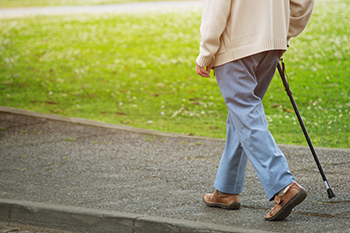
Falling can be dangerous. This can apply to any age group, and it is especially helpful for seniors to be aware of how the feet can become injured from falling. It is beneficial for elderly people to be acutely aware of their surroundings, which may falter as the aging process occurs. Getting adequate sleep and leading a healthy lifestyle may be good fall prevention techniques. One of the best things seniors can do for their body is to engage in a gentle exercise and stretching program. This is effective in building and maintaining strength in various parts of the body, which may help to reduce the number of falls. It may also aid patients in getting up quicker after falling, as a result of improved flexibility. There are prevention methods that can be implemented in the household. These can include removing worn rugs from the living area, and installing grab bars in the toilet and shower area. If you would like to know more about how falling can affect the feet and possible prevention methods, it is suggested that you consult with a podiatrist who can provide you with useful information.
Preventing falls among the elderly is very important. If you are older and have fallen or fear that you are prone to falling, consult with Steven Wells, DPM from Favor Foot Ankle Leg & Wound Center. Our doctor will assess your condition and provide you with quality advice and care.
Every 11 seconds, an elderly American is being treated in an emergency room for a fall related injury. Falls are the leading cause of head and hip injuries for those 65 and older. Due to decreases in strength, balance, senses, and lack of awareness, elderly persons are very susceptible to falling. Thankfully, there are a number of things older persons can do to prevent falls.
How to Prevent Falls
Some effective methods that older persons can do to prevent falls include:
- Enrolling in strength and balance exercise program to increase balance and strength
- Periodically having your sight and hearing checked
- Discuss any medications you have with a doctor to see if it increases the risk of falling
- Clearing the house of falling hazards and installing devices like grab bars and railings
- Utilizing a walker or cane
- Wearing shoes that provide good support and cushioning
- Talking to family members about falling and increasing awareness
Falling can be a traumatic and embarrassing experience for elderly persons; this can make them less willing to leave the house, and less willing to talk to someone about their fears of falling. Doing such things, however, will increase the likelihood of tripping or losing one’s balance. Knowing the causes of falling and how to prevent them is the best way to mitigate the risk of serious injury.
If you have any questions, please feel free to contact our office located in Edison, NJ . We offer the newest diagnostic and treatment technologies for all your foot care needs.
Falls Prevention
Elderly Americans are very susceptible to falls as they get older. Everyone experiences decreases in flexibility, balance, strength, and the senses as they age. This correlates to some eye-opening statistics. 1 in 4 Americans aged 65 and older fall each year. An elderly American is being treated for a fall in an emergency room every 11 seconds, and every 19 minutes, an older person dies from falling. In light of these striking statistics, one can see the importance of taking steps to prevent falls.
Finding an exercise program for the elderly is an excellent way to reduce the likelihood of falls. Look for an exercise program that improves strength and balance. Elderly people who live a more sedentary lifestyle, with little physical activity, are at an increased risk of falling. Wearing well-fitted footwear that provides good foot support and cushion will help prevent falls from poorly fitted shoes. Talking to a podiatrist about your susceptibility to falls and about inspecting your prescriptions will help to avoid any medication that could make falls more likely. Due to a decline in the senses among the elderly, having your eyes and hearing checked is recommended.
Around half of all falls occur in the household. Removing tripping hazards in the home and making it more accommodating to older persons can significantly reduce falls. Some notable household changes include increasing lighting around the house, installing grab bars in the shower and bathroom, and making sure the floor is clear of clutter. Other smart options include installing a shower chair, using rubber-bottomed rugs, and placing railings on both sides of stairwells.
Finally, discuss with a doctor and your family about your fear of falling. This will help to increase awareness among the population on the need for fall prevention. A lack of awareness on the matter, and a downplaying of importance are what increase the risks of falling. Following these tips can help to reduce the risk for yourself and your loved ones.
Common Reasons for Foot Pain During Workouts

Regardless of the type of exercise you choose to do, there is often specific footwear designed to achieve the best results for that activity. The right shoes can help with proper form and preventing foot pain during exercise. Consider that if you feel pain during or after your workouts, you may be wearing the wrong shoes for the activity. Additionally, your shoes could be worn out, or the shoes may not be the right ones for your foot type. A gait analysis involves watching how you walk without shoes to understand how your feet bear weight as you walk. This is often a starting point to recommending a shoe type for your individual gait pattern. Shoes can differ by pronation type, arch support, and other foot mechanic specifics. If you experience foot pain during your workouts, it is suggested that you visit a podiatrist for an examination, a gait analysis, and a discussion about the best shoes for you.
Sports related foot and ankle injuries require proper treatment before players can go back to their regular routines. For more information, contact Steven Wells, DPM of Favor Foot Ankle Leg & Wound Center. Our doctor can provide the care you need to keep you pain-free and on your feet.
Sports Related Foot and Ankle Injuries
Foot and ankle injuries are a common occurrence when it comes to athletes of any sport. While many athletes dismiss the initial aches and pains, the truth is that ignoring potential foot and ankle injuries can lead to serious problems. As athletes continue to place pressure and strain the area further, a mild injury can turn into something as serious as a rupture and may lead to a permanent disability. There are many factors that contribute to sports related foot and ankle injuries, which include failure to warm up properly, not providing support or wearing bad footwear. Common injuries and conditions athletes face, including:
- Plantar Fasciitis
- Plantar Fasciosis
- Achilles Tendinitis
- Achilles Tendon Rupture
- Ankle Sprains
Sports related injuries are commonly treated using the RICE method. This includes rest, applying ice to the injured area, compression and elevating the ankle. More serious sprains and injuries may require surgery, which could include arthroscopic and reconstructive surgery. Rehabilitation and therapy may also be required in order to get any recovering athlete to become fully functional again. Any unusual aches and pains an athlete sustains must be evaluated by a licensed, reputable medical professional.
If you have any questions please feel free to contact our office located in Edison, NJ . We offer the newest diagnostic and treatment technologies for all your foot and ankle needs.
Sports Related Foot And Ankle Injuries
Foot and ankle injuries are common among people who participate in sports. Several factors contribute to this. They include failing to stretch or warm up properly, not wearing the proper type of shoe and not taping or providing other types of support for the ankle or foot. The most common foot and ankle injuries suffered by people involved in sports are plantar fasciitis, ankle sprains and Achilles tendon damage or ruptures. If not treated properly, they can lead to permanent disability.
Treating these injuries is relatively simple if they are identified and addressed early. Many athletes dismiss the initial aches and pains associated with injury as just soreness or tired muscles. Their first response is usually to try to work through it. This can lead to serious problems. Many minor injuries are made far more serious when athletes continue to put strain and pressure on them. That attitude can change a mild strain into a serious strain and a minor tear into a rupture. Athletes should have unusual aches and pains evaluated by a skilled medical professional.
Plantar fasciitis is a painful injury. It is inflammation of the plantar fascia, the thick band of tissue running from the heel to the base of the toes. If left untreated, it can lead to a degenerative disease called plantar fasciosis. There are several effective treatments for this ailment. Doctors often prescribe rest, massages, stretching, night splints, physical therapy, anti-inflammatory medication, corticosteroids or surgery, usually in that order. The most effective treatment for plantar fasciitis is orthotics, which offers foot support. Surgery is occasionally used as a last resort, but it comes with the risk of nerve damage and infection and often does not stop the pain.
The Achilles tendon is the largest tendon in the body. It connects the calf muscles to the heel bone. Running, jumping and walking all impact this tendon. Two common injuries to the Achilles tendon are tendonitis and a rupture of the tendon. Tendonitis is inflammation in the tendon often caused by an increase in the amount of stress placed on it. Non-surgical treatments include rest, ice or anti-inflammatory medication. A rupture (tear) of the Achilles tendon can be treated by placing the lower leg in a cast for several weeks or with surgery. Many physicians feel surgery is the better option because it lowers the risk of re-ruptures. Both methods require 4 to 6 months of rehabilitation.
Ankle sprains are the most common sports related foot and ankle injury. A sprain occurs when the ligament holding the ankle bones and joint stretches beyond its normal range. It can be treated non-surgically with a combination of rest, ice wrapped around the joint for 30 minutes immediately after injury, compression by a bandage and elevating the ankle above the heart for 48 hours. This combination is referred to as RICE. Severe ankle sprains in which the ligaments are torn may require reconstructive surgery followed by rehabilitation.
An Ankle Injury May Cause Cuboid Syndrome
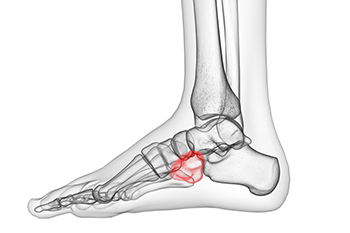
The cuboid bone is located on the outside of the foot and is one of seven tarsal bones. Cuboid syndrome occurs when this bone partially dislocates, which can happen from an injury. An ankle sprain may cause the peroneal muscles to put excess pressure on this tarsal bone, leading to pain and discomfort. An effective treatment method may include performing specific types of stretches that can help to loosen tight peroneal muscles. Additionally, the bone may be manipulated back into its normal position, and it may help to pad and tape the foot for extra stability. Many patients find getting a deep tissue massage can relax the calf and peroneal muscle, which can eliminate pressure on the cuboid bone. If you have endured an injury, and have pain on the outside of your foot, it is suggested that you confer with a podiatrist who can properly diagnose and treat cuboid syndrome.
Cuboid syndrome, also known as cuboid subluxation, occurs when the joints and ligaments near the cuboid bone in the foot become torn. If you have cuboid syndrome, consult with Steven Wells, DPM from Favor Foot Ankle Leg & Wound Center. Our doctor will assess your condition and provide you with quality foot and ankle treatment.
Cuboid syndrome is a common cause of lateral foot pain, which is pain on the outside of the foot. The condition may happen suddenly due to an ankle sprain, or it may develop slowly overtime from repetitive tension through the bone and surrounding structures.
Causes
The most common causes of cuboid syndrome include:
- Injury – The most common cause of this ailment is an ankle sprain.
- Repetitive Strain – Tension placed through the peroneus longus muscle from repetitive activities such as jumping and running may cause excessive traction on the bone causing it to sublux.
- Altered Foot Biomechanics – Most people suffering from cuboid subluxation have flat feet.
Symptoms
A common symptom of cuboid syndrome is pain along the outside of the foot which can be felt in the ankle and toes. This pain may create walking difficulties and may cause those with the condition to walk with a limp.
Diagnosis
Diagnosis of cuboid syndrome is often difficult, and it is often misdiagnosed. X-rays, MRIs and CT scans often fail to properly show the cuboid subluxation. Although there isn’t a specific test used to diagnose cuboid syndrome, your podiatrist will usually check if pain is felt while pressing firmly on the cuboid bone of your foot.
Treatment
Just as the range of causes varies widely, so do treatments. Some more common treatments are ice therapy, rest, exercise, taping, and orthotics.
If you have any questions, please feel free to contact our office located in Edison, NJ . We offer the newest diagnostic and treatment technologies for all your foot care needs.
Cuboid Syndrome
Cuboid syndrome mostly affects athletes, although it can affect non-athletes too. It is also known as cuboid subluxation or cuboid fault syndrome. This condition occurs when joints and ligaments near the cuboid bone of the foot are damaged, or when the cuboid bone itself is dislodged from its natural position. It is usually marked by pain on the outer side of the foot, which may be persistent or may come and go. Cuboid syndrome can be difficult to diagnose unless it becomes severe and more noticeable. Your doctor will likely ask questions about when the pain began and how long it has been present, and will put pressure on the cuboid bone to determine if that area is the origin of the pain.
Causes of Cuboid Syndrome
- Any repetitive stresses placed on the foot due to athletic activities are a common cause of cuboid syndrome.
- Although it develops over time, it is possible that this syndrome can occur all of sudden due to a single event or injury.
- Over-pronation can exacerbate the condition if not corrected.
Disagreements Amongst Podiatrists Regarding Cuboid Syndrome
- Some refer to it as the dislocation of the calcaneal-cuboid joint only.
- Other podiatrists see it as an injury of the ligaments located nearby, which also involves the cuboid bone.
It is very important that when you experience any kind of pain on the side of your foot, you should seek medical care right away. If a subluxed cuboid is caught early, your feet may respond well to the treatment, and you can get back into sports or other activities again as soon as the pain subsides.
Toes May Fracture Easily
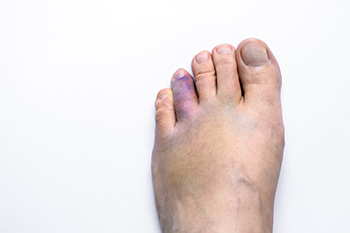
A broken toe can easily happen as a result of being located at the end of the body. Broken toes may occur if a heavy object drops on them, or if the toe is stubbed into a piece of furniture. Broken or fractured toes are easy to notice because swelling and bruising occurs immediately. It is a painful injury and an X-ray is often taken which can determine the severity of the fracture. Additional symptoms can include a popping sound at the time of injury and it is often difficult to walk. A mild break can be treated by using the buddy taping method, which is done by taping the affected toe to the toe next to it. Buddy taping is often successful in providing the necessary stability as the healing process takes place. For severely broken toes, surgery may be necessary to replace any protruding bones in addition to realigning the toes to their normal position. If you have broken your toe, it is suggested that you speak with a podiatrist who can help you with the treatment that is best for you.
Broken toes may cause a lot of pain and should be treated as soon as possible. If you have any concerns about your feet, contact Steven Wells, DPM from Favor Foot Ankle Leg & Wound Center. Our doctor will treat your foot and ankle needs.
What Is a Broken Toe?
A broken toe occurs when one or more of the toe bones of the foot are broken after an injury. Injuries such as stubbing your toe or dropping a heavy object on it may cause a toe fracture.
Symptoms of a Broken Toe
- Swelling
- Pain (with/without wearing shoes)
- Stiffness
- Nail Injury
Although the injured toe should be monitored daily, it is especially important to have a podiatrist look at your toe if you have severe symptoms. Some of these symptoms include worsening or new pain that is not relieved with medication, sores, redness, or open wounds near the toe.
If you have any questions, please feel free to contact our office located in Edison, NJ . We offer the newest diagnostic and treatment technologies for all your foot care needs.

